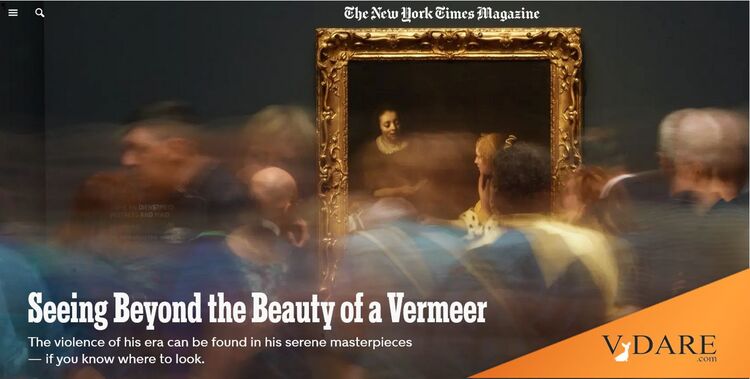
Nigerian-American Teju Cole In The NYT: You White People Should Feel Guilty Over Vermeer
By Steve Sailer
06/04/2023
From The New York Times:
Seeing Beyond the Beauty of a Vermeer
The violence of his era can be found in his serene masterpieces — if you know where to look.
By Teju Cole
Published May 25, 2023
The afternoon I discovered Vermeer, I was passing time by browsing the books and publications piled up on the shelves at home in Lagos. I was 14 or 15. Amid the relics of my parents’ college studies (Nigerian plays, French histories, business-management textbooks), I found something unfamiliar: the annual report for a multinational company. I don’t remember which company it was, but it must have had something to do with food or drink, because on the front cover was a painting of peasants in a rolling field and on the back was a painting of a woman pouring milk.
… I am still moved by the quiet miracle of that boyhood afternoon. But my relationship with art has changed. I look for trouble now. No longer is a Vermeer painting simply “foreign and alluring.” It is an artifact inescapably involved in the world’s messiness — the world when the painting was made and the world now….
The curators of the Rijksmuseum have brought together, in a much-praised exhibition, the largest number of paintings by Vermeer ever assembled, 28 of the surviving 35 or so generally agreed to be by him. It is a feat of coordination by the organizers and of generosity by the lenders, a gathering unlikely to be repeated in this generation at such a scale.
… But what was really beginning to grate on me was the breathless critical acclaim. The name Vermeer is, by now, a shorthand for artistic excellence and so much of the praise for the exhibition sounded like emotional shorthand too. Greatness, perfection, sublimity: the appropriate vocabulary for a certain kind of cultural experience.
… The Dutch East India Company dominated maritime routes and its shareholders raked in profits. The Dutch West India Company, meanwhile, was a significant force in the trade in enslaved people. Ordinary Dutch citizens grew wealthy from these criminal enterprises.
… In his perceptive book “Vermeer’s Hat” (2008), the historian Timothy Brook draws out some of the global provenances of the things we see in Vermeer’s paintings. He suggests, for instance, that the silver on the table in the “Woman Holding a Balance” could have had its origin in the notorious Potosí silver mine, a hellish place run on the labor of enslaved people in what was then Peru and is now Bolivia. The felt lining the hat of the soldier in “Officer and Laughing Girl” almost certainly came from beaver pelts sourced by French adventurers from the violent trade networks of 17th-century Canada.
… The beddejak in “Woman in Blue Reading a Letter,” Martine tells me, is painted with ultramarine, the rarest and most expensive of the blue pigments that would have been available to a 17th-century Dutch painter. Ultramarine was made from lapis lazuli, which was imported into Western Europe from Afghan mines … But who was mining the lapis lazuli in Afghanistan and under what conditions?
… If real, the pearls would have been harvested by pearl divers in the Gulf of Mannar, between present day Sri Lanka and India. In her right hand is a quill pen, paused. Underneath it, a streak of white paint perfectly denotes a sheaf of white paper. The ornate writing box, of different kinds of wood and with round metal studs, is most likely from Goa under Portuguese rule. Made by whom? I found myself asking again. Under what conditions?

This is such a fascinating topic that let’s not talk about the child laborers in Africa who mined some of the exotic minerals used in the iPhone in Teju Cole’s pocket in 2023.
But that’s not the point, the point is that Vermeer was white, and that makes Nigerian-American Teju Cole feel kind of inadequate, so equity demands that white people give black people their home equity.
